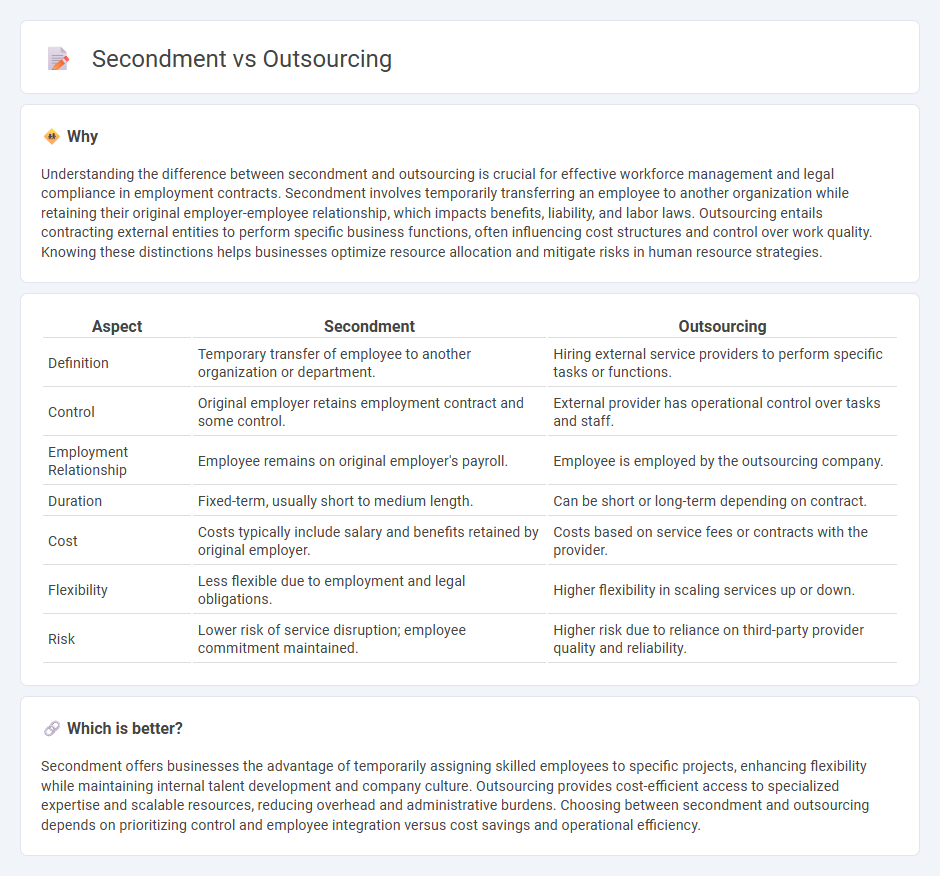
Secondment involves temporarily assigning employees to another organization while maintaining their original employment status, promoting skill transfer and internal development. Outsourcing, by contrast, delegates entire business functions to external service providers, aiming to reduce costs and enhance operational efficiency. Explore the key differences and strategic benefits of secondment versus outsourcing to optimize your workforce management.
Why it is important
Understanding the difference between secondment and outsourcing is crucial for effective workforce management and legal compliance in employment contracts. Secondment involves temporarily transferring an employee to another organization while retaining their original employer-employee relationship, which impacts benefits, liability, and labor laws. Outsourcing entails contracting external entities to perform specific business functions, often influencing cost structures and control over work quality. Knowing these distinctions helps businesses optimize resource allocation and mitigate risks in human resource strategies.
Comparison Table
| Aspect | Secondment | Outsourcing |
|---|---|---|
| Definition | Temporary transfer of employee to another organization or department. | Hiring external service providers to perform specific tasks or functions. |
| Control | Original employer retains employment contract and some control. | External provider has operational control over tasks and staff. |
| Employment Relationship | Employee remains on original employer's payroll. | Employee is employed by the outsourcing company. |
| Duration | Fixed-term, usually short to medium length. | Can be short or long-term depending on contract. |
| Cost | Costs typically include salary and benefits retained by original employer. | Costs based on service fees or contracts with the provider. |
| Flexibility | Less flexible due to employment and legal obligations. | Higher flexibility in scaling services up or down. |
| Risk | Lower risk of service disruption; employee commitment maintained. | Higher risk due to reliance on third-party provider quality and reliability. |
Which is better?
Secondment offers businesses the advantage of temporarily assigning skilled employees to specific projects, enhancing flexibility while maintaining internal talent development and company culture. Outsourcing provides cost-efficient access to specialized expertise and scalable resources, reducing overhead and administrative burdens. Choosing between secondment and outsourcing depends on prioritizing control and employee integration versus cost savings and operational efficiency.
Connection
Secondment and outsourcing both serve as strategic workforce solutions that enhance organizational flexibility by reallocating human resources. In a secondment, an employee is temporarily assigned to another department or organization to gain experience or fulfill specific project needs, maintaining their original employment status. Outsourcing involves contracting external firms to perform business functions, enabling companies to reduce costs and focus on core activities while leveraging specialized expertise.
Key Terms
Contractual Agreement
Outsourcing contracts typically define service levels, deliverables, and pricing, emphasizing third-party responsibility for specific business functions. Secondment agreements outline temporary employee assignments, detailing terms of employment, confidentiality, and duration between the sending and receiving organizations. Explore our detailed guide to understand key differences and best practices in contractual agreements for outsourcing and secondment.
Control and Supervision
Outsourcing involves delegating tasks to an external organization with limited control over day-to-day operations, while secondment entails temporarily assigning employees to another company under continuous supervision and direct control by the original employer. In outsourcing, the hiring company manages outcomes through contracts without direct oversight of workers, whereas secondment maintains employer-employee relationships and supervisory authority during the assignment. Explore more to understand how control and supervision impact outsourcing and secondment arrangements in various industries.
Employment Relationship
Outsourcing shifts the employment relationship from the client company to the external service provider, where the provider hires and manages its own employees, minimizing the client's direct employment responsibilities. Secondment maintains the original employment relationship between the employee and the client company while temporarily assigning the employee to work for another organization under the same employment contract. Explore the detailed distinctions between outsourcing and secondment to understand their impact on employment law and workforce management.
Source and External Links
What is Outsourcing? Definition, Advantages, and Examples - Outsourcing is a business practice where companies contract third-party providers to perform tasks or services previously handled in-house, offering cost savings, access to expertise, and improved focus on core activities.
What is Outsourcing and How Does it Work? - Outsourcing involves hiring external parties, such as large firms or freelancers, to manage operations or provide services, emphasizing the importance of managing partnerships and service contracts effectively.
Outsourcing - Outsourcing refers to the use of external providers to execute business processes that would otherwise be done internally, including both domestic and foreign contracting, and is distinct from but often combined with offshoring.
 dowidth.com
dowidth.com